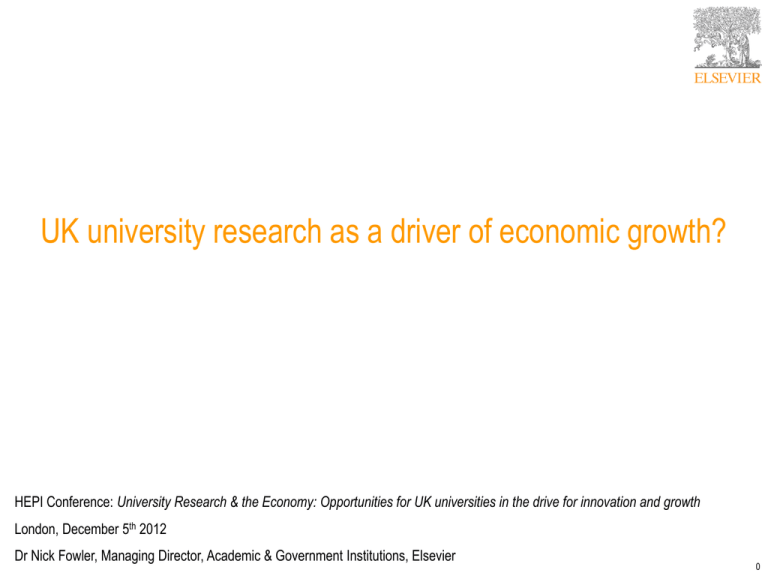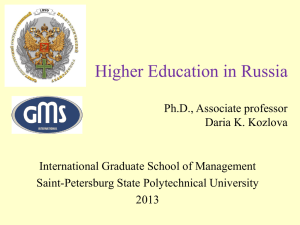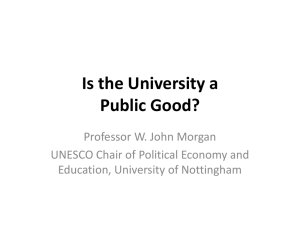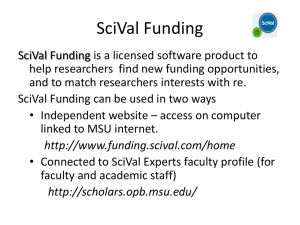Nick Fowler – HEPI conference Autumn 2012
advertisement

UK university research as a driver of economic growth? HEPI Conference: University Research & the Economy: Opportunities for UK universities in the drive for innovation and growth London, December 5th 2012 Dr Nick Fowler, Managing Director, Academic & Government Institutions, Elsevier 0 How UK universities drive economic growth UK universities generate £59 billion for the UK (2009 UUK study) •Employ 382,000 members of staff •Develop/train future employees: 1.9MM undergraduates and 600,000 post-graduates per year •Spend £27 billion annually on goods and services •Develop ideas and IP, “Innovation”, business and community interaction –Commercialization of new knowledge –Delivery of professional training, consultancy, facilities and equipment, and services (£3.3B) –License income, patents, spin-offs, new businesses 1 University research as a driver of economic growth? UK, EU Government policy 2 UK university research as a driver of economic growth: UK Government policy Strategy “Build on the UK’s recognised strengths” “Work with business and the knowledge base to underpin private sector growth” “Maximise the impact of our research base on economic growth” Policies, instruments, actions • • • • • • • • • • • £4.6 billion budget: science and research programmes £150MM each year supporting university-business interactions “Catapult” technology and innovation centres “Launchpad” (innovation clusters) Technology Strategy Board R&D Tax Credits for SMEs, £75MM “Smart” grants for SME R&D Collaborations - China and India “Design-driven innovation” “Get rid of red tape” “Make public sector data more accessible” “Inducement prizes” 3 UK university strategy = UK Industrial Strategy? “It’s all about creative interactions between science and business. “You get innovation when great universities, leading-edge science, world-class companies and entrepreneurial start-ups come together. “Where they cluster together, you get some of the most exciting places on the planet. “What is where you find the creative ferment which drives a modern economy.” Rt Hon George Osbourne MP, Chancellor of the Exchequer Royal Society, 9th November 2012 4 UK Industrial Strategy: prioritised areas Big data and energy efficient computing Synthetic Biology Agri-Science Advanced materials Regenerative Medicine Energy Storage Robotics and autonomous systems Satellites, commercial applications of space 5 University research as a driver of economic growth? EU Government policy European Commission Strategy “...Stabilise the financial and economic system ... create the economic opportunities of tomorrow... “...Research and Innovation... ...help deliver jobs, prosperity, quality of life and global public goods... ... generate the scientific and technological breakthroughs needed to tackle the urgent challenges society faces... ...have therefore been placed at the centre of the Europe 2020 strategy to promote smart, sustainable and inclusive growth.” 6 University research as a driver of economic growth? EU Government policy European Commission Policies, instruments, actions •Three “pillars” (1) Excellent Science (2) Industrial Leadership (3) Societal Challenges •Initiatives: –Innovation Union flagship initiative –European Research Council –Future and Emerging Technologies –Marie Curie actions –Research infrastructures, E-infrastructures. •Overall: “prioritises spending with immediate impact on growth and jobs”. 7 University research as a driver of economic growth? EU Government policy Word count • Research, researchers: 76 • Industry, industries, enterprise(s), SMEs: 37 • Finance, financial: 15 • Economy, economic: 12 • University, universities: 0 8 University research as a driver of economic growth? US developments. 9 The role of university research: time to reflect? UK universities:2012 and beyond? Three questions to reflect upon 1. What are universities for? 2. Just because universities can and do deliver economic growth, should they be managed to? 3. How will universities adapt, what will consequences be? 10 Reflection (1): What are universities for? “At an absolute minimum, the modern university might be said to possess at least the following four characteristics: 1. ...Provides some form of post-secondary-school education... more than professional training... 2. ...Furthers some form of advanced scholarship or research... not wholly dictated by the need to solve immediate practical problems... 3. ...Activities are pursued in more than just one single discipline... 4. ...Enjoys some form of institutional autonomy ...” Source: Stefan Collini, “What are Universities For?” Penguin Books, 2012, p7. Emphasis added. 11 Reflection (2): Should universities be managed to drive economic growth just because they can? 12 Reflection (3): How will universities adapt, what will the consequences be? 13 Rising demand for management information: (1) Current Research Information Systems (CRIS): example - Pure 14 Adoption of Current Research Information Systems in UK (Pure only) 2008: 0 Source: SciVal 2012: 20 15 Change in grant income from Research Councils, 2012 vs 2011 Universities with Pure Universities without Pure +12% -11% Income 2011 (£Million): 161 593 Income 2012 (£Million): 180 531 Change 2011-2012 (£Million): +19 -62 Sample includes those 20 UK universities that account for the most research council grant income awarded, 2012 Source: SciVal 16 Rising demand for management information: (2) Demand for comparative data and metrics: example, Snowball Metrics http://www.snowballmetrics.com/ 17 Rising demand for management information: (3) Demand for information tools Source: SciVal Spotlight 18 Rising demand for management information: (4) Rise of Showcasing – UK examples UK Universities UK Funding Bodies UK Government 19 Rising demand for management information: Research Networking Systems—ReachNC / SciVal Experts (4) Rise of Showcasing – US example, North Carolina http://www.experts.scival.com/reachnc/ Summary 21








